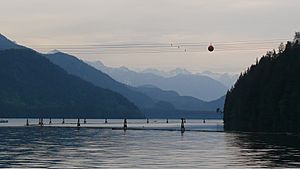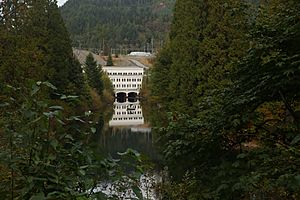Stave Lake facts for kids
Quick facts for kids Stave Lake |
|
|---|---|
 |
|
| Location | Mission, British Columbia |
| Coordinates | 49°22′N 122°18′W / 49.367°N 122.300°W |
| Type | reservoir, natural lake |
| Basin countries | Canada |
| Surface area | 55 km2 (21 sq mi) |
Stave Lake is a large body of water in British Columbia, Canada. It's both a natural lake and a reservoir. A reservoir is like a big storage tank for water, often created by building a dam. The water from Stave Lake is used to make hydroelectricity, which is electricity created by the power of moving water.
This lake is located on the northern edge of the District of Mission, about 65 kilometers (40 miles) east of Vancouver. The main part of the lake stretches about 20 kilometers (12 miles) from north to south. Another arm, which ends at the Stave Falls Dam, is about 9.5 kilometers (6 miles) long. Today, the lake covers an area of about 55 square kilometers (21 square miles). Before the dam was built, the lake was much smaller, only about one-third of its current main size.
The area around the Stave River, which feeds the lake, was once the home of the Skayuks people. They were a group of Coast Salish people who spoke the Halqemeylem language. The river was full of salmon, and huge red cedar trees grew in the valley. These trees attracted companies that wanted to cut them down for lumber and shingles, like Stave Lake Cedar Ltd. The lower part of the Stave River is now called Hayward Lake. This lake was formed by the Ruskin Dam. Near Hayward Lake, there's a recreation area and a trail that follows an old railway line.
Contents
What is the Climate Like at Stave Lake?
Stave Lake has an oceanic climate, which means it has mild temperatures and a lot of rain. The average amount of rain and snow each year is about 2,359.4 millimeters (92.9 inches).
The weather can change quite a bit. The coldest temperature ever recorded was -26.7°C (-16.1°F) on January 31, 1929. The hottest temperature was 40.0°C (104.0°F) on June 25, 1925.
| Climate data for Stave Lake (Stave Falls) (Elevation: 110m) 1981−2010 | |||||||||||||
|---|---|---|---|---|---|---|---|---|---|---|---|---|---|
| Month | Jan | Feb | Mar | Apr | May | Jun | Jul | Aug | Sep | Oct | Nov | Dec | Year |
| Record high °C (°F) | 16.5 (61.7) |
19.4 (66.9) |
27.2 (81.0) |
32.2 (90.0) |
35.6 (96.1) |
40.0 (104.0) |
39.4 (102.9) |
38.9 (102.0) |
36.7 (98.1) |
30.0 (86.0) |
20.0 (68.0) |
19.4 (66.9) |
40.0 (104.0) |
| Mean daily maximum °C (°F) | 5.6 (42.1) |
8.0 (46.4) |
10.6 (51.1) |
14.7 (58.5) |
17.8 (64.0) |
20.5 (68.9) |
23.7 (74.7) |
24.0 (75.2) |
21.4 (70.5) |
14.1 (57.4) |
8.7 (47.7) |
5.4 (41.7) |
14.5 (58.1) |
| Daily mean °C (°F) | 3.1 (37.6) |
4.4 (39.9) |
6.6 (43.9) |
9.8 (49.6) |
12.8 (55.0) |
15.5 (59.9) |
18.1 (64.6) |
18.3 (64.9) |
15.9 (60.6) |
10.5 (50.9) |
6.0 (42.8) |
3.0 (37.4) |
10.3 (50.5) |
| Mean daily minimum °C (°F) | 0.6 (33.1) |
0.9 (33.6) |
2.5 (36.5) |
4.9 (40.8) |
7.8 (46.0) |
10.4 (50.7) |
12.4 (54.3) |
12.7 (54.9) |
10.3 (50.5) |
6.9 (44.4) |
3.3 (37.9) |
0.7 (33.3) |
6.1 (43.0) |
| Record low °C (°F) | −26.7 (−16.1) |
−15.6 (3.9) |
−12.2 (10.0) |
−4.4 (24.1) |
−1.1 (30.0) |
1.7 (35.1) |
1.1 (34.0) |
3.3 (37.9) |
−1.1 (30.0) |
−5.6 (21.9) |
−13.9 (7.0) |
−23.3 (−9.9) |
−26.7 (−16.1) |
| Average precipitation mm (inches) | 300.7 (11.84) |
211.1 (8.31) |
215.7 (8.49) |
191.6 (7.54) |
148.3 (5.84) |
137.7 (5.42) |
82.0 (3.23) |
81.7 (3.22) |
102.7 (4.04) |
235.6 (9.28) |
370.8 (14.60) |
281.6 (11.09) |
2,359.4 (92.89) |
| Average rainfall mm (inches) | 265.0 (10.43) |
197.9 (7.79) |
210.3 (8.28) |
191.4 (7.54) |
148.3 (5.84) |
137.7 (5.42) |
82.0 (3.23) |
81.7 (3.22) |
102.7 (4.04) |
235.6 (9.28) |
363.2 (14.30) |
258.1 (10.16) |
2,273.8 (89.52) |
| Average snowfall cm (inches) | 35.7 (14.1) |
13.2 (5.2) |
5.5 (2.2) |
0.2 (0.1) |
0.0 (0.0) |
0.0 (0.0) |
0.0 (0.0) |
0.0 (0.0) |
0.0 (0.0) |
0.0 (0.0) |
7.6 (3.0) |
27.6 (10.9) |
89.6 (35.3) |
| Average precipitation days (≥ 0.2 mm) | 23 | 17.8 | 21.1 | 19.5 | 18.1 | 16.2 | 10.7 | 10.5 | 11.6 | 19.7 | 23.6 | 23.0 | 214.9 |
| Average rainy days (≥ 0.2 mm) | 21.2 | 17.0 | 21.2 | 19.5 | 18.1 | 16.2 | 10.7 | 10.5 | 11.6 | 19.7 | 23.3 | 21.2 | 210.2 |
| Average snowy days (≥ 0.2 cm) | 4.8 | 2.2 | 1.2 | 0.11 | 0.0 | 0.0 | 0.0 | 0.0 | 0.0 | 0.0 | 1.3 | 4.1 | 13.71 |
| Source: Environment Canada (normals, 1981−2010) | |||||||||||||
How Were the Dams Built?
The Stave Falls Power Company started building dams on the Stave River between 1920 and 1922. This company later became part of the British Columbia Electric Railway. They built the Stave Falls Dam and Powerhouse, along with homes for workers, a community hall, and a railway line called the Stave Falls Branch.
When these dams were finished, the water level in the Upper Stave River rose a lot. This caused the forests to flood. The same thing happened later with Hayward Lake, which was created when the Ruskin Dam and Powerhouse was completed in 1930. For many years, the flooded cedar trees remained underwater. However, in the 1980s and 1990s, crews from a nearby prison camp worked to remove the timber. They did this by temporarily lowering the lake's water level.
After the dam was built, old logging railways were used to cut down more trees further north in the Stave Valley. Part of the movie We're No Angels was filmed at the Stave Dam area. They even built a large fake town and a big timber church on stilts in Stave Lake for the movie! After filming, the whole set was taken down, but a small gazebo (a covered outdoor structure) was moved to the Hayward Lake Recreation Site.
Who Lives Near Stave Lake?
Most of the land around Stave Lake is owned and managed by BC Hydro, a company that provides electricity. There are a few private cabins on the east side of the lake. Also, Zajac Ranch, a summer camp for children with special needs, is located on the southwest side of the lake.
You can get to the east side of the lake by using Sylvester Road. If you look at satellite images of the lake, you might even spot a large raft that floats around during the summer months!
What Can You Do for Fun at Stave Lake?
Stave Lake is a popular spot for 4x4 vehicles and dirt-biking. This is because there are many wide, muddy areas on the southwest side of the lake that are perfect for these activities.



